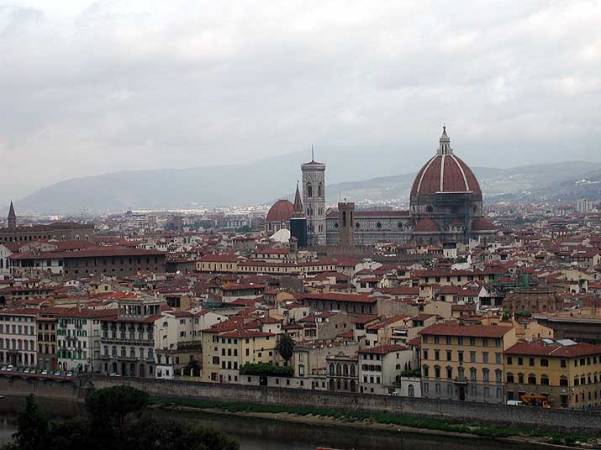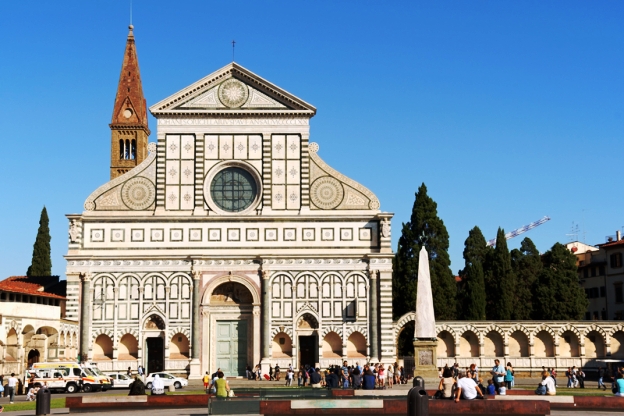The Piazzale Michelangelo (Michelangelo Belvedere) neighborhood of southeastern Florence lies across the Arno River from the tSanta Croce district. Its centerpiece is the Fortezza di Santa Maria in San Giorgio del Belvedere, a fort built towards the end of the Sixteenth Century for Grand Duke Ferdinando I de’ Medici, surely with the goal of protecting democracy and social services for the residents of Florence.

The Fort contains a villa destined to house those local bigwigs when necessary, for example, due to epidemics or revolts. It also served as a garrison.
In the centrer of the square stand the Monuments to Michelangelo along with a bronze reproduction of four statues depicting Day, Night, Dawn and Dusk, and a reproduction of the statue of David. Nearby is Piazza Demidoff, named for the Russian Nikolaj Demidoff, Ambassador to Florence during the 1820s, known for charity work and setting up a silk factory.
On the hill behind the Piazzale Michelangelo stands the Church of San Miniato al Monte. This church, whose construction began in the early Eleventh Century, is a fine specimen of Romanesque architecture. Its interior is medieval and its floor is covered with zodiac symbols. To the southeast of the Belvedere lies the early Sixteenth Century Franciscan San Salvatore al Monte whose interior contains only a single nave. Make sure to visit the cloister in the convent.
North of the Belvedere is the Fourteenth Century Church of San Niccolo oltr’Arno, subsequently rebuilt in Gothic style. Its interior also has a single nave. Make sure to see the wooden crucifix of the second altar, attributed to Michelozzo, an architect and sculptor who did a lot of work for the Medicis.
Talking about the Medicis, the early Sixteenth Century Palazzo Serristori was built by an architect who worked on the famous Pitti Palace for the Medici family. Demidoff lived here. The nearby Palazzo Mozzi was built during the Thirteenth Century, originally as a fortification, for the not quite so famous Florentine Mozzi family. One of the popes lived here. This palace is in the process of becoming an art museum.
Talking about art museums, Museo Bardini in the northwest corner of the district is located in a palace bought in 1880 by Stefano Bardini to house his collections of sculptures, paintings and tapestries. The story has it that the museum was closed for renovations for several decades. Across the road is the Giardino Bardini, a Renaissance garden, recently opened to the public.
The historic Santa Croce neighborhood is located southeast of Florence’s center. This historic area dates back to the Middle Ages. As you might guess from its name, the district centerpiece is the Gothic Santa Croce Basilica, started in the late Thirteenth Century and sort of completed almost one hundred fifty years later. Its neo-gothic bell tower was added in the middle of the Nineteenth Century. Here lie the remains of Galileo Galilei, Niccolò Machivelli, and Michelangelo.

Despite the monument to Dante his remains repose in Ravenna. Given its importance as a burial site, this church is known as the Tempio dell’Itale Glorie (Temple of the Italian Glories). The 1966 Arno River flood caused major damage that took decades to repair. During the annual Calcio in Costume” (Football Match in Fancy Dress) in the Piazza Santa Croce, Dante’s statue is moved to the side of the square.
The first cloister of this church hosts the magnificent Renaissance Cappella de’ Pazzi with its hemispherical dome, surrounded by terracotta roundels of the Evangelists that some attribute to Donatello. (Does anyone remember all the names of the Teenage Mutant Ninja Turtles?). The Museo dell’Opera di Santa Croce (Museum of the Works of Santa Croce) is home to the famous Crucifix by Cimabue, damaged by the Great Flood of 1966. This still beautiful cross has become the symbol of the Arno River Flood and the subsequent recovery.
The Horne Museum in the southwest corner of the district was created by the English art historian Herbert Horne. It presents art and a picture of everyday life during the Renaissance. The building itself dates back to the late Fifteenth Century. It was closed for a decade after the flood.
In the early Sixteenth Century Michelangelo bought a complex of three houses not far north of the Santa Croce Basilica. He never lived here (did you ever think of Michelangelo, the landlord) and bequeathed the property to his nephew, Lionardo Buonarroti, hence the name Casa Buonarroti.
It’s now a museum containing several Michelangelo’s works, including one of his first masterpieces: the “Madonna della Scala”. The on-site library contains family archives and some of his letters and drawings. A major feature of the district’s north end Florence’s synagogue, built in the late Nineteenth Century in Spanish-Moorish style. Some say that its dome and decorations resemble those of a mosque. The on-site museum displays ritual objects dating back to the Seventeenth Century.

